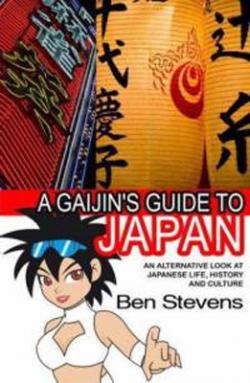A Gaijin’s Guide to Japan

Review by Ali Muskett
A Gaijin’s Guide to Japan is a fine place to start if you have a mild interest in Japan which needs nurturing. However, if you’re already a bit of a Japanophile, it might not be the best book for you to read. It is written in an A-Z format, and doesn’t really go into any one topic in much depth (“Buddhism” is a mere three pages, for example, while “sushi” barely makes a page).
As a comment on style, I would like to note that the author tends to use a strange mixture of spellings of Japanese words, which results in some entries being found in slightly bizarre places. For example, the entry about “Capsule Hotels” isn’t found under “C” where I would expect to find it, or even under “H” for hotel. It’s under “K.” Why? Because the Japanese spelling for capsule hotel is “kapuseru hoteru” (written as カプセルホテル in katakana). But, to be honest, the average “gaijin”reading this book probably isn’t going to know that. This is a book written for foreigners – foreigners who are interested in Japan but feel they need an A-Z guide – so I don’t think it’s very sensible to order things by their Japanese spelling (unless they are recognised words, such as sushi or kimono). I wouldn’t mind so much if he was consistent (although I would still disagree with the choice). However, “Kapuseru Hoteru” (Capsule Hotel), “Chikatetsu Sarin Jiken [地下鉄サリン事件] (Subway Sarin Incident, which does at least have the English translation, although it’s still under “C”), “Sarariman” [サラリーマン] (Salaryman) and “Hosutesu Bar” [ホステスバー] (Hostess Bar) are all under their Japanese spellings. So why then use the correct English spelling for other entries, such as “Taxis” or “Golf,” which can be written in katakana, too. And why can I find shrine’ under “J” for “Jinja” [神社] (the Japanese word for shrine) but temples under “Temples”, not “(o)tera” [お寺] (the Japanese word). It just isn’t consistent.
Another comment on style, is regarding listing by surname. Of course, I can’t dispute that “David Beckham” (who, believe it or not, makes an appearance in this book along with Cameron Diaz) be listed under ‘B’. However, Japanese pop-punk band ‘Shonen Knife‘ [少年ナイフ] can be found under ‘K’ – “Knife, Shonen”. Isn’t that like listing the Sex Pistols under ‘Pistols, Sex’?!
As a final comment on style, I must add that I would love to have a chat with the copy-editors on this book, as I noticed a number of simple errors whilst reading (to list just one example, on page 28, “packed Toyo commuter trains“, I assume, should read “Tokyo commuter trains“). However, this was a review copy, so I guess there’s a chance this was an early print.
Ben Stevens only lived in Japan for about a year I think, although according to his website he returns to Nagasaki every year, presumably to see his wife’s family. I don’t doubt that he knows a lot about Japan, and I’m sure his Japanese is probably better than mine (having a Japanese wife usually helps with that!), but I still think that one year’s experience does not maketh a comprehensive A-Z guide on Japan! I feel there are many glaring oversights in this book and, whilst I am aware that, of course, not everything can be included, I wonder how Stevens could have missed such entries as “Omamori” [御守] (or, “Good luck charms” – the kind you buy at shrines) or “Eikaiwa” [英会話] (or, “English Conversation Schools”), which would surely interest the typical reader of this book. There is an entry for “Sensu” [扇子] (the Japanese folding fan), but I don’t recall seeing any mention at all of “Uchiwa” [うちわ], the popular Japanese flat fan, which everyone uses at summer festivals. Even if it’s not worthy of its own entry, I would be inclined to give it a mention under “Sensu”. (And, this is a personal gripe, which I understand isn’t important to most people… On page 92, Stevens mentions Kit Kats, but fails to mention that there are, in fact, many interesting and bizarre regional flavours of Kit Kat in Japan. He simply mentions the green tea flavoured ones. He’s missing out if he hasn’t experienced Hokkaido’s “Jagga Butter” [じゃがバター味 キットカット] (jacket potato with butter) flavoured Kit Kats!
A Gaijin’s Guide to Japan is supposed to be a light, amusing read. But I found the humour pretty hit-or-miss, and at times I found the author’s attitude towards Japanese culture and customs, quite frankly, insulting. Insulting to the Japanese, and insulting to other foreigners living in Japan and actually wanting to learn about the culture and experience new things. For example, at the end of the short entry on “Keigo” [敬語] (or, honorific speech), the author writes “However, don’t worry about it if you’re a gaijin, as it’s yet another thing you’re not supposed to know the slightest thing about“. Um… OK. If you say so, Mr. Stevens. As the old saying goes, “you can’t judge a book by the cover,” but this book does have an awesome cover.

